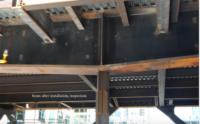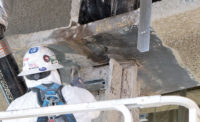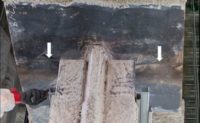Salesforce Transit Center Girder Cracks' Inquiry is Closely Scrutinized by Independent Panel

Fissure in the bottom flange of one of two flawed steel girders in San Francisco's Salesforce Transit Center. The hub, which opened on Aug. 10, has been closed since Sept. 25 and will remain closed until a fix is installed.
Photo Courtesy of Transbay Joint Powers Authority
An independent panel of experts in steel structures, fracture mechanics and metallurgy is reviewing every step taken by the Transbay Joint Powers Authority team investigating the cause of two cracked girders at the Salesforce Transit Center in San Francisco. TJPA, which opened the 4.5-block-long depot on Aug. 12, shuttered it on Sept. 25, after a ceiling installer noticed a deep fissure in one of the twin girders spanning 80 ft across Fremont Street.
Specimens, called coupons, of the cracked areas in the girders’ bottom flanges are under scrutiny at LPI Inc. in New York City. TJPA expects to have the results of the LPI investigation by the end of November. Concurrent with testing and analysis, the TJPA team is considering various potential repair strategies, "to expedite the construction schedule once a cause is determined," said TJPA, in a statement released Nov. 27.
Initiating discontinuity, material fracture toughness and the level of stress in the regions of the cracks “all play a role in brittle fracture and are being looked at under the microscope,” says Michael D. Engelhardt, a professor of civil engineering at the University of Texas, Austin, and the chair of the peer review panel.
The Metropolitan Transportation Commission assembled the panel in October, at the joint request of San Francisco City and County Mayor London N. Breed and Oakland Mayor Libby Schaaf. MTC is the transportation planning, financing and coordinating agency for the nine-county San Francisco Bay Area.
The panel’s job is to review the findings from LPI and the results of the finite element analysis from LPI and the hub’s structural engineer Thornton Tomasetti. The panel is not charged with investigating, says Engelhardt, who declines to speculate about the specific causes of the failures.
Veterans of Structural Investigations
Engelhardt is a veteran of structural investigations. He was an ENR newsmaker in 1994, after 1994’s Northridge earthquake in Los Angeles, which caused numerous welds to come unzipped at connections of steel frames. Under enormous time pressure, Engelhardt devised an economical, laboratory-tested seismic-resistant moment connection, with horizontal cover plates reinforcing beam flanges, to solve the cracked weld problem for new construction.
Another MTC panel member and veteran of structural investigations is John W. Fisher, professor emeritus of civil engineering at Lehigh University. Fisher, one of the world’s foremost fracture mechanics experts, was ENR’s Man of the Year in 1987 for advancing steel technology by investigating problems such as welding jumbo steel shapes in tension.
Other panel members are Brian Kozy, principal engineer of the Federal Highway Administration; Thomas A. Sabol, a principal at Englekirk Structural Engineers and an adjunct professor of civil engineering at the University of California, Los Angeles; and fabrication expert Robert E. Shaw Jr., president of the Steel Structures Technology Center and a member of the structural welding committee of the American Welding Society.
Bus Depot
Before the problems surfaced, the 1.2-million-sq-ft transit center was functioning as a bus depot, with three levels above grade and a 5.4-acre rooftop park. The third-floor Fremont Street tapered plate girders, which span north-south, support the park directly above and the second-floor bus level—via a hanger at the midspan—directly below the girder level.
In a joint Oct. 4 letter to Steve Heminger, MTC’s executive director, the mayors said, “There are many questions about what might have caused the [girders] to crack, who might be responsible, and how the [girders] will be repaired…. These questions must be answered quickly and the public needs to trust the answers.”
The letter requests that MTC form the panel to review and verify the findings of the TJPA team’s analysis. “It is critical to the constituents of our cities and our region that there be confidence in the findings” of the TJPA analysis, said the mayors in the letter.
The MTC panel’s scope of work included a review of the load capacity of the girders' emergency shoring systems, before they were installed under the girders on Fremont Street and under a similar girder system that spans First Street. The First Street girders have not cracked. Shoring there was installed as a precautionary measure.
The panel also reviewed the sampling and testing plan for the material cut from the fractured girders. This meant participating in decisions about which girder material should be removed and sent to LPI, to avoid “destroying forensic evidence,” says Engelhardt.
In addition to reviewing the cause of the failures, as informed by the material test results and design analysis, the panel will review the current condition of the depot's structural elements directly affected by the steel fractures. This is to assure the final structure is safe after the repair. “We provide input on elements that need to be examined,” says Engelhardt.
No Collapse
When the cracks initiated, there was no collapse. Likely, there was a redistribution of the load, agree the investigators. The analysis of the load redistribution, another part of the investigation, is important to make sure other structural elements in the region of the girders did not subsequently become overstressed, says Engelhardt. “The girders frame into other members, which need to be looked at for due diligence,” he adds.
Finally, the MTC panel will review the repair solution, as informed by the cause of the fractures and the current conditions of the structure in the region of the fractures.
Engelhardt says: “There has been total consensus” reached at each step along the way between the MTC panel and TJPA investigators, which include the hub’s original structural peer reviewers.







